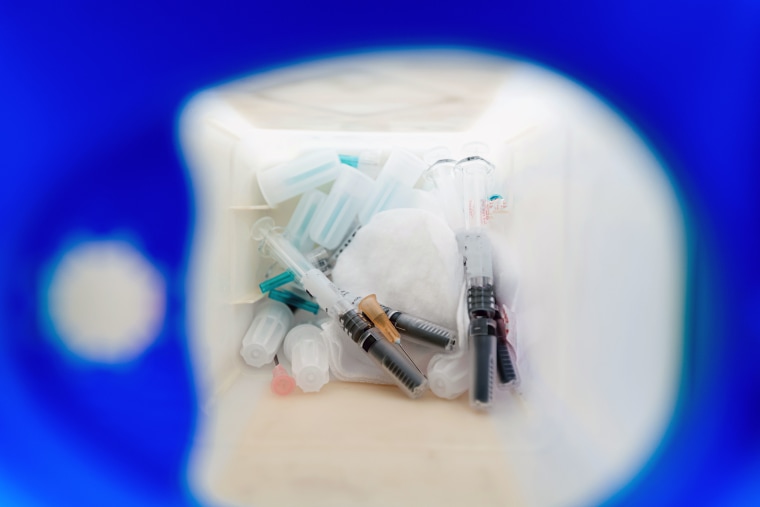Leah F. is a harm reductionist in Alabama. A full-time college student with EMT training, she runs one of the only harm reduction organizations in the state. Alabama law forbids some essential harm reduction services, like naloxone distribution and syringe exchange, forcing Leah, 37, to remain anonymous and affecting the way she can help people who use drugs. TODAY is identifying her by her middle name at her request to protect her privacy.
In an essay for TODAY, she shares more about her work and what it's like providing harm reduction services in an area where they aren't always welcome.
In 2013, it felt like I was losing a friend to overdose every week or so, and I felt really helpless and angry. A few years later, someone brought up harm reduction and once I realized that was an option, I just ran with it. Coincidentally, a few weeks later a friend who lived next door to me overdosed. I had Narcan, and we were able to get her back. Two weeks later I enrolled in EMT school. That was the beginning of everything.
There's no such thing as an average day for me. I'm never not working. I operate my harm reduction organization full-time out of my house, and it's just meetings, meetings, phone calls, meetings. I see clients at my house, where I try to help them mitigate whatever they're going through at the moment and help them create stable foundations upon which to build happier, healthier lives.
I see some people who are really struggling with substance use, some who are having trouble navigating the health care system, some who have health issues complicated by an inability to get to the doctor or find a doctor sympathetic to the fact that they use drugs. So within the best of my ability and what's legal, I try to assess their situation and say, "You need to go to an emergency room right now," or help them create solutions or strategies that suit their individual needs and wants
When I'm not doing that, I do work in the community and push for policy changes. I get a small amount of operating funds — about $15,000 this year — from the Comer Foundation, a Chicago organization that supports health and education projects in the U.S. The change I can aboveboard make is incremental and at a snail's pace, so there can be a lot of asking for forgiveness, not permission.
For example, syringe exchange is illegal, but syringe disposal isn’t, so I do a lot of disposal projects in town. Used syringes remaining in circulation results in syringe litter, and there can be infections, which can escalate into more severe medical issues. Through a grant, I provided boxes and disposal service for used syringes, but that also gave me access to speak with people and check on wounds and do some education about safer use. That project got me on the public health stage. We were able to take tens of thousands of those used needles off the streets and collect over a hundred pounds of syringe litter. Every one of those needles gone is another potential infectious disease eradicated.
Beyond that, I help people get tested for HIV and hepatitis, which are infections that people can get by reusing syringes. I also help them navigate the medical system. I've not had anyone test positive for HIV, but I've gotten four people into treatments for hepatitis C and am more than prepared for the eventuality of linking someone to HIV services when it’s needed.
Every one of those needles gone is another potential infectious disease eradicated.
In addition to the drug safety work I've been able to do, I've also been able to practice larger tenets of harm reduction by just trying to make people's lives a little safer. I've gotten three or four people off the street, out of tents and into housing, in just a few months. I've reversed a lot of overdoses.
It's slow, but policy and perception are changing. We’ve found creative ways into the system by working in the policy arena. I work with the Alabama Department of Public Health and with local organizations and colleges to do advocacy work. We just got fentanyl test strips removed from the list of arrestable legal paraphernalia this year, so people can't be in trouble for having those.
Even with all of this, at the end of the day, I’m still a one-person show with a few volunteers who help me out, so I'm always on the clock. On top of that, I'm a student. I take classes online, which makes it easier, but I can be up until five or six in the morning doing homework. I have a really hard time stepping away, because I’m afraid that if I’m not home to open the door or answer the phone, someone could actually die as a result. I know that’s not usually the case, but that's how my brain works. It’s really heavy and frustrating, because I see the impact of not having harm reduction-based policies in place.
Harm reduction is just meeting people where they are. It’s basically just trying to reintroduce humanity and compassion to the community that I serve. It’s not just syringe litter and health care. I recently rented the other side of the duplex I live in to use as an office space, and I want to use the kitchen there to make food for unhoused people to bring back to camp, or bring cookies to pass around on the holidays, or just do those little things that remind people that we are the same and that I'm here for them.
This interview has been edited and condensed.
